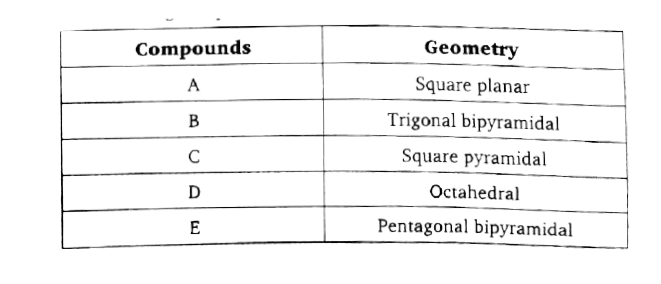A white precipitate of AgCl dissolves in excess of :
(I)NH3(aq) (II)Na2S2O3 (III)NaCN
III only
I, II, III
I, II
I only
The correct Answer is:B
Step by step video solution for A white precipitate of AgCl dissolves in excess of : (I)NH_(3)(aq) (II)Na_(2)S_(2)O_(3) (III)NaCN by Chemistry experts to help you in doubts & scoring excellent marks in Class 12 exams.
Updated on:21/07/2023Topper's Solved these Questions
- d-BLOCK ELEMENTSBOOK - VK JAISWAL ENGLISHCHAPTER - d-BLOCK ELEMENTSEXERCISE - Level 3
36 Videos
- d-BLOCK ELEMENTSBOOK - VK JAISWAL ENGLISHCHAPTER - d-BLOCK ELEMENTSEXERCISE - ONE OR MORE ANSWER IS/ARE CORRECT
44 Videos
- d-BLOCK ELEMENTSBOOK - VK JAISWAL ENGLISHCHAPTER - d-BLOCK ELEMENTSEXERCISE - SUBJECTIVE PROBLEMS
6 Videos
- CO-ORDINATION COMPOUNDSBOOK - VK JAISWAL ENGLISHCHAPTER - CO-ORDINATION COMPOUNDSEXERCISE - SUBJECTIVE PROBLEMS
42 Videos
- ENVIRONMENTAL CHEMISTRYBOOK - VK JAISWAL ENGLISHCHAPTER - ENVIRONMENTAL CHEMISTRYEXERCISE - ASSERTION-REASON TYPE QUESTIONS
14 Videos
Similar Questions
In salts of polyatomic anion, as polarising power of cation increase, thermal stability of the salt decrease and decomposed species may further undergo redox reaction
Q. Which of the followinng species undergoes non-redox thermal decomposition reaction on heating?
View SolutionWhat changes occur when acidified Cr2O2−7 ion react with H2O2 solution in presence of ether solvent?
View SolutionCalculate the magnetic moment of a high-spin octahedral complex that has six electrons in 3d-orbitals
View SolutionConsider the following compounds with their regular geometries.

Calculate value of (x+y−z)2, where x is total number of axial d-orbitals having zero nodal plane, y and z are total no. of non-axial and axial d-orbitals respectively each one having two nodal planes used in hybridisation of central atoms of compounds A to E.
View SolutionAssertion (A) Green house effect was observed in houses used to grow plants and these are made of green glass.
Reason (R) Green house name has been given because glass houses are made of green glass.
View SolutionWhich of the following halides react(s) with AgNO_(3(aq)) to give a precipitate that dissolves in Na_(2)S_(2)O_(3(aq))
View SolutionThe precipitate of AgCI dissolves in an excess of NH_(3) , KCN and Na_(2)S_(2)O_(3) solution respectively, producing complex ions represented by the following chemical formulae
View SolutionA white percipitate of AgCl dissolves in excess of
I)NH3(aq) II)Na2S2O3 III)NaCn
View SolutionAgCl dissolved in excess of NH3,KCN and Na2S2O3 solutions the complex produces ions
View SolutionNol. Of following reagents in which ppt A is soluble is
AgNO3+NaCl→A↓
(i) aq. NH3
(ii) aq. KCN
(iii) Na2S2O3
(iv) Conc. HCl
(v) aq. NaoH
(iv) aq. Kl
View Solutionदिए हुए हाइड्रोजन (hydrogen halides) में से कौन AgNO3 (जलीय) से क्रिया पर ऐसा अवक्षेप (precipitate) देते है जो कि Na2S2O3 (जलीय) में घुल जाते है ?
View SolutionWhcihg of the following hydrogen halides react (s) with AgNO_(3) (aq) to give a precipitate that dissolves in Na_(2)S_(2)O_(3) (aq)
View SolutionNa2S2O3 में एक विलयन की मोलरता 3M तथा विशिष्ट घनत्व 1.25 ग्राम/मिली है । ज्ञात करो । (i) विलयन की सांद्रता % द्रव्यमान में (ii) Na2S2O3 का मोल प्रभाज ,(iii) Na+ तथा S2O2−3 आयन की मोललता ।
View SolutionThe reaction of I, with Na_(2)S_(2)O_(3) gives Nal and
View Solutionदिए हुए हाइड़्रोजब हैलाइडों (hydrogen halides) में से कौन AgNO3 (जलीय) से क्रिया पर ऐसा अवक्षेप (precipitates) देते हैं, जोकि Na2S2O3 (जलीय) में घुल नहीं पते है ?
View SolutionA white precipitate of AgCl dissolves in excess of :
(I)NH3(aq) (II)Na2S2O3 (III)NaCN
View Solution

